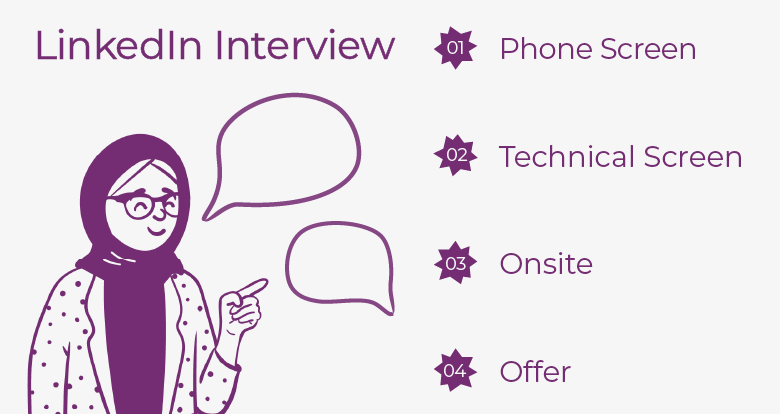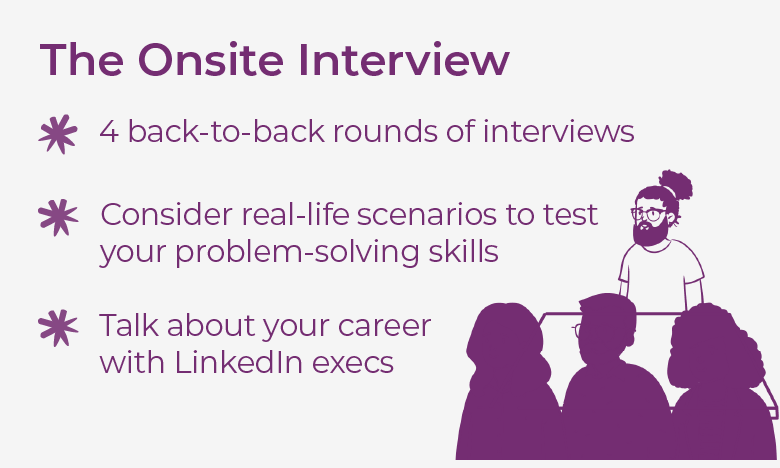Interviewing at LinkedIn: Your Social Media Clout Matters
Everything you need to know about the interview process at this professional networking company.
Did you know that half of all US adults with college degrees use LinkedIn? As the world’s largest professional networking site, with 660 million users in over 200 countries and territories across the globe, LinkedIn offers talent solutions that help people find jobs, take career-enhancing online courses, network with colleagues and recruiters, and reconnect with former classmates. Some people even land their dream job through the resources LinkedIn provides.
True to its company mission, LinkedIn invests heavily in its employees’ professional development. The company devotes one Friday each month to inDay, which includes a speaker series (previous speakers include financier Suze Orman and Salman Khan, founder of Khan Academy), as well as a Hackday competition. Engineers form teams, work on any project they can dream up, put it together in one day, and present it to the entire organization, including executive management.
Do you want to work for this top tech company? We're breaking down the interview experience and discussing what life as a LinkedIn employee is like if you land the job.
We'll cover the following sections:
- The interview process: phone screen, technical screen, and onsite
- Tips for success
- Common interview questions
- What the job is like
- How promotions work
LinkedIn Interview Process

How long does it take to get hired at LinkedIn?
LinkedIn reports an average time to hire of 41 days, down from 83, after the Product team overhauled its hiring practices in 2018. Sixty-six percent of those surveyed on Indeed report the process taking less than a month.
Compared to other big tech companies, this is pretty standard. For example, Google takes 2 months on average, while Microsoft takes 2-4 weeks on average.
Phone screen with a recruiter
The initial phone screen follows a standard format: a 30-minute conversation to assess the candidate’s motivations, key qualifications, and career goals. LinkedIn reports that the majority of its hires come from internal referrals or recruiters scouting candidates on the site, so be sure to actively post and update your profile.
Hiring managers advise candidates to show they’re aware of recent LinkedIn news and updates. Mention a recent article in LinkedIn’s Talent Blog, a LinkedIn Learning course you recently took, or recent industry development highlighted in your ‘news and views’ feed.
👉 Practice recent LinkedIn interview questions here.
Technical phone screen with a hiring manager
LinkedIn’s technical phone interview tends to focus on 2-3 questions, each of which test one or two core competencies in-depth. Even for non-technical roles, this interview round will focus on assessing your qualifications for the job. For instance, a candidate interviewing for a product role would be asked:
Software engineering candidates should be prepared to answer questions about data structures, algorithms, scalability, and object-oriented design. Don’t get preoccupied with memorizing every algorithm. Instead, focus on important principles such as how to implement algorithms on trees, modified BFS and DFS algorithms, as well as sorting and recursion.
👉 Practice recent LinkedIn interview questions here.
Onsite interviews (approx. 4 rounds)

Final LinkedIn interviews are typically conducted onsite, although the company appears to be hosting interviews virtually at the moment. Expect at least four rounds of back-to-back interviews that test your problem-solving ability in real-life scenarios relevant to the job description.
Sales managers, for example, might simulate a formal sales pitch. Technical candidates take on a coding challenge reflective of real issues LinkedIn programmers encounter, such as code review, system architecture and design, troubleshooting, and incident response. One site reliability engineer reported on Glassdoor that they were given a scenario where the number of registrations for a new service had dropped to zero and they were asked to simulate an incident response and evaluation.
If you perform well, you’ll be asked to meet with a few senior LinkedIn executives. This final discussion is focused on your career development and how a prospective role at LinkedIn could help you grow.
👉 Practice recent LinkedIn interview questions here.
Offer
Most employees report receiving an offer within one week of the onsite interview. Under LinkedIn’s newly streamlined hiring process, each interviewer has 24 hours to submit feedback about the candidate. Each candidate receives a rating of 1-5 across four competencies specific to the role.
Next, each interviewer is asked point-blank: “Would you hire this person for this position?”
LinkedIn offers a generous relocation assistance program that includes temporary housing and assistance with finding daycares or schools. For recent graduates or current students, the hiring manager places them in a LinkedIn group with other employees who can help them figure out which neighborhoods to live in or even find roommates.
👉 What's it actually like to work at LinkedIn? Find out here.
Extra Tips to Help You Succeed

Up your LinkedIn game
Before applying for a role at LinkedIn, beef up your LinkedIn profile. Update your headline to reflect your area of expertise, write an ‘about’ summary that captures your professional history and career goals, and detail your responsibilities and accomplishments in previous roles. During any job search, your LinkedIn profile is a key marketing tool -- even more so in this case.
Show that you actively post status updates and articles, comment on other’s posts, and cultivate quality connections. If you’ve used products liked LinkedIn Learning or upgraded to a Premium account, you’ll feel more at ease when asked to discuss why you chose to apply for a role at LinkedIn or what improvements you would make if you were hired.
Find a connection who works at LinkedIn to refer you
Try to find a LinkedIn employee who can vouch for you, even if it’s a second or third-degree connection. Doing so shows you understand LinkedIn’s value as a professional networking tool. Also, make sure to research and connect with your prospective interviewers on LinkedIn ahead of time. During the interview, mention something on their profile that intrigued you.
LinkedIn wants to hire people with an entrepreneurial mindset
Hiring managers gauge whether you know how to sell, code, and drive results, but they also view each applicant’s potential. Can you build relationships? Have you taken on challenges where others didn’t want to? Did you see potential to add value and scale something beyond what you initially intended?
LinkedIn looks for people with an entrepreneurial spirit who are ready to build something -- although these traits seem to be a standard requirement at tech companies these days.
Common Interview Questions

Behavioral interview questions...
- Tell me about yourself.
- What is your greatest strength?
- Tell me about a time when you had to ask for help.
- What has been your greatest professional achievement?
- Tell me about a time you changed someone's mind at work.
- Give me an example of a time you dealt with conflict at work.
- What does your dream job look like?
- At your last job, what was the biggest mistake you made? How did you reconcile the situation?
- Where do you see yourself in 5 years?
- Why LinkedIn?
Technical interview questions (i.e. software engineer)...
- For a given set of non-negative integers, find the number of subsets that add up to a target value ‘k’.
- You take over a new service and discover it has no monitoring. What monitoring would you put in place within the first week to ensure the service is working?
- You are designing the client side of a survey website. Provide a list of classes and methods you would use to break the problem down.
- Suppose you have a list of dishes, where each dish is associated with common ingredients. Create an algorithm to group together dishes with common ingredients.
- Describe a situation where something you suggested resulted in an improved process or created a big impact.
- Describe a situation where you proposed a design idea and it was rejected.
- Write a program that takes an integer and prints out all the ways to multiply smaller integers that equal the original number, without repeating sets of factors.
- Write a function that takes a number and returns the square root.
- How would you design a system to provide the top trending topics in the last five minutes/1 hour/24 hours?
- Given two valid dictionary words of the same length, write a function that returns the minimum number of steps to go from the first word to the second word.
Product manager interview questions...
- What’s a product you love/hate? Why?
- What’s a LinkedIn feature you love/hate? Why?
- How would you improve LinkedIn?
- How would you improve LinkedIn's Endorse feature?
- How would you improve LinkedIn's User / Business profile page?
- How would you improve LinkedIn's Onboarding process?
- How would you improve LinkedIn Messenger?
- How would you improve LinkedIn Jobs?
- How would you improve Enterprise engagement on LinkedIn?
- How would you design an app to search for apartments to rent?
What's The Job Like?

It's pretty well known throughout the tech world that LinkedIn has a great culture and its work-life balance is among the best for big companies. Of course, WLB varies by team, but as a whole, employees report that the pace of work is reasonable (even slow at times) and most don't work outside of their regular hours.
Perhaps LinkedIn's generous time-off policy is one reason that its WLB is top-notch. The company offers unlimited DTO and 2 week-long shutdowns. Since LinkedIn's culture is a bit more relaxed, unlimited time off works quite well (employees don't feel pressured to continue working when they need time off).
An employee on Blind described the time-off policy at LinkedIn:
“We have two company-wide, week long shutdown periods every year and 7 paid holidays. That’s 17 days of no work, and we may be getting a third week long shutdown period, making 22 days. We also have 12 InDays (1 Friday per month) that’s focused around your self, team or community development. Beyond that, it’s unlimited DTO so as long as you get your time off approved by your manager, you can take it off.”
Some report a slow pace of work and office politics that can get in the way. However, most say these things aren't dealbreakers and are made up for by the WLB and benefits. An employee said on Blind:
“On a serious note, except for some politics and general ‘slowness’, it’s a great place."
LinkedIn's company culture is generally highly regarded as inclusive and supportive. A Blinder reviewer explained:
“I was pleasantly surprised at how inclusive the culture is despite being a larger company. They do a very good job of making you feel welcome while onboarding you. Work-life balance is one of the best, and the food was of course amazing (and I’ve eaten at a lot of companies).”
On Indeed, a recruiter at LinkedIn had very positive things to say about the company:
“There is heavy investment in employee happiness and it’s something you see and feel every day. The company can be a bit slow to move on certain processes, as it is very tall and wide with its organizational structures. Career advancement is also very competitive and can be a slow and daunting process. Company benefits are excellent and employee morale and retention is amazingly high.”
👉 Learn more about LinkedIn's culture: Working in LinkedIn's Rest and Vest Culture
How Promotions Work

A recurring sentiment from LinkedIn employees is that you have to create impact to get promoted. Some report that the promotion process tends to be competitive, political, and pretty difficult overall.
While it's difficult to get promoted, LinkedIn isn't known for getting rid of underperformers either. Companies like Facebook, for example, have time limits on how long people can remain at the same level before they're fired.
Nor does LinkedIn put many of its employees on PIP (performance improvement plan) which companies like Amazon are notorious for doing. Managers can put employees on PIP, but it's rare and is usually reserved for people that continue to underperform despite feedback. A review on Blind described:
“Pip is reserved for the people that somehow slipped through the interview gap and just can't do the work at all, personally witnessed 2 who simply can't execute or ask for the right help.”
So, if you're content with remaining at the same level, or "resting and vesting," you can generally get away with it, but be aware that managers may pass you up on opportunities.
If you hope to move up the ladder at LinkedIn, there are some things you should know. As previously stated, promotions are tough at LinkedIn. This is especially true for SWE:
- From SWE --> Senior SWE: This promotion generally takes between 1 to 3 years. It can be done in 1 year if you can hit the ground running. You need to work with your manager to get a project that’s large enough to add to your promotion packet.
- From Senior SWE --> Staff: This promotion is tough. It can sometimes take 4+ years, and some don't make it to Staff at all.
Regarding promotion to Staff, a review on Blind said:
"'Good performer' is not good enough, you need to Exceed Expectations and perform at Staff level for a while”
Here are some things to keep in mind if you're aiming for a promotion:
- You have to perform above your current level
- You'll probably need a project at the caliber of the level above you
- You need a good manager who likes you
- You need a bit of luck with the reviewers -- added points if they like you
LinkedIn falls very short on refreshers
People in the industry often say LinkedIn doesn't offer refreshers. Let's see why.
LinkedIn typically gives a large refresh at cliff time to bring you back to target TC at your level. But aside from this, LinkedIn doesn't guarantee refreshers.
LinkedIn gives annual refreshers to top performers, but this is uncommon. A good chunk of the average and bottom performers get nothing. Since LinkedIn does performance reviews on a 5 scale system, people getting a 4/5 and up can expect refreshers. So aside from that, you shouldn't expect refreshers unless you're at the low end of your band.
The amount of refreshers you get really depends on your manager and your org, but the amount will often be just enough to get you to the midpoint of the band for your level.
The information provided herein is for general informational purposes only and is not intended to provide tax, legal, or investment advice and should not be construed as an offer to sell, a solicitation of an offer to buy, or a recommendation of any security by Candor, its employees and affiliates, or any third-party. Any expressions of opinion or assumptions are for illustrative purposes only and are subject to change without notice. Past performance is not a guarantee of future results and the opinions presented herein should not be viewed as an indicator of future performance. Investing in securities involves risk. Loss of principal is possible.
Third-party data has been obtained from sources we believe to be reliable; however, its accuracy, completeness, or reliability cannot be guaranteed. Candor does not receive compensation to promote or discuss any particular Company; however, Candor, its employees and affiliates, and/or its clients may hold positions in securities of the Companies discussed.
